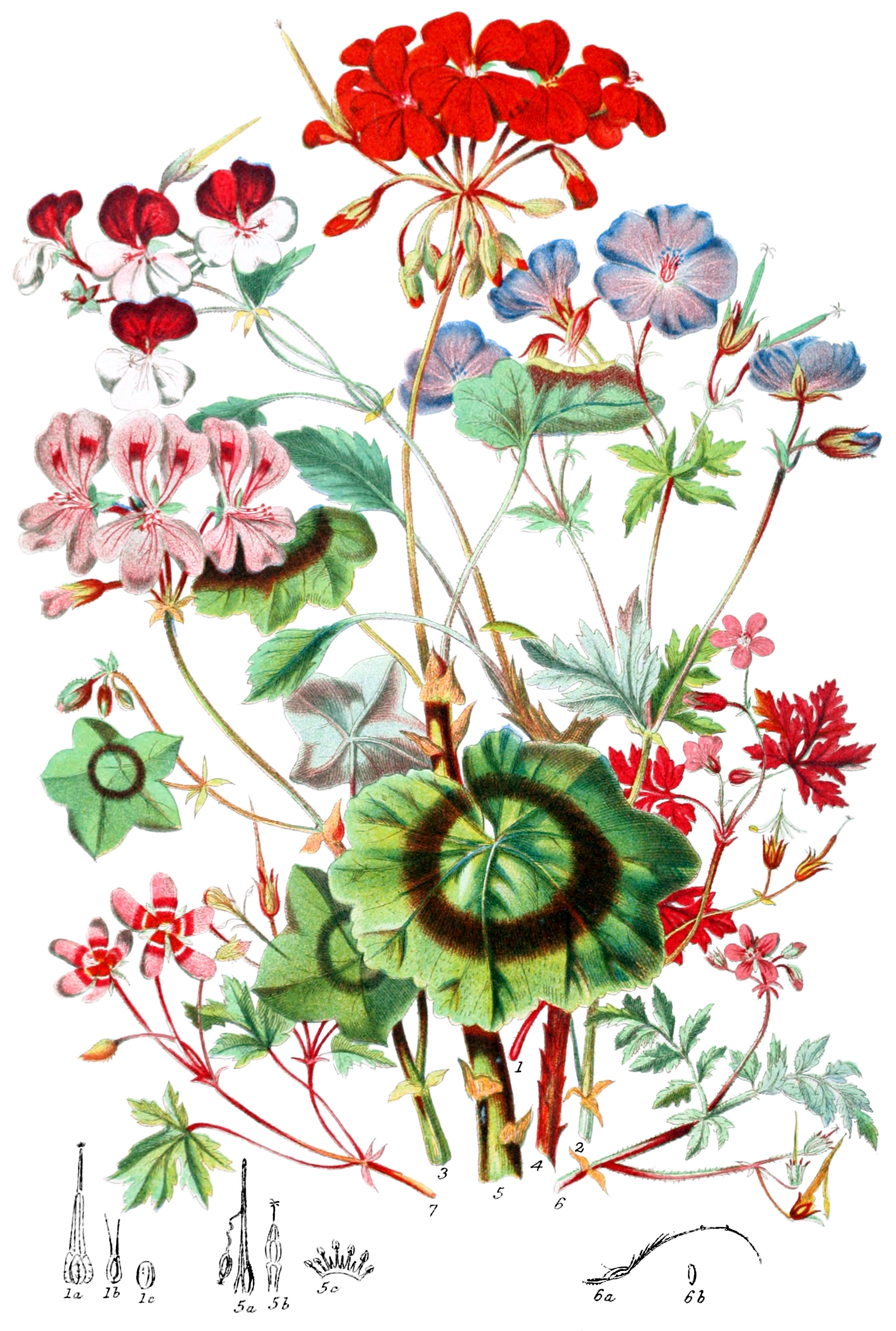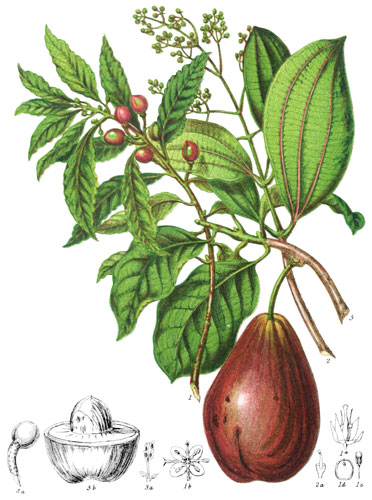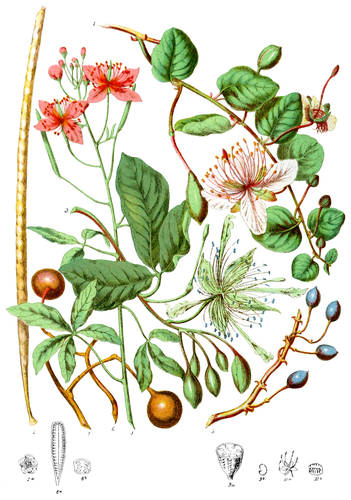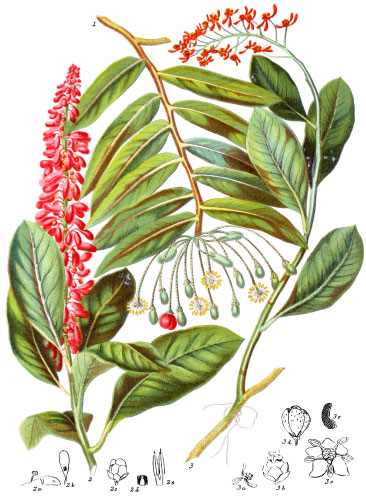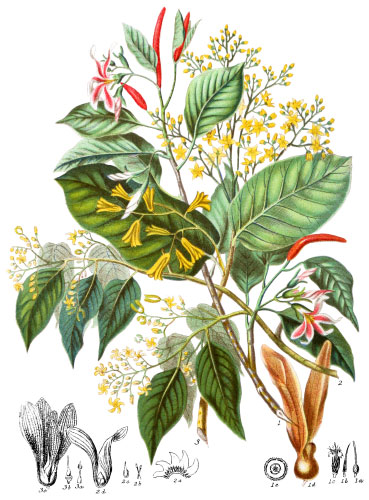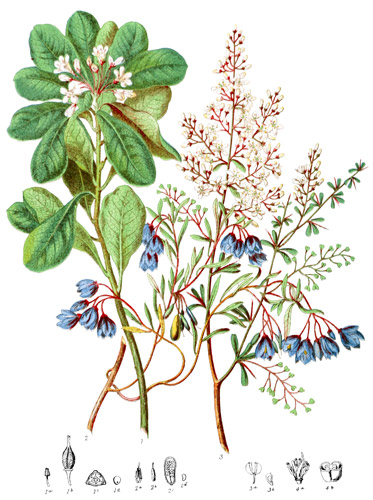Key characteristics
Undershrubs and herbaceous plants, the stems of which are enlarged at the joints, and separable when young. The leaves are mostly simple, the lower opposite, the upper alternate, with membranaceous stipules. The roots of some are tuberous. The calyx is formed of five persistent sepals, ribbed, more or less unequal, the lower sepal sometimes spurred at the base, or prolonged into a hollow nectary down the flower-stalk. The petals are five, seldom four, clawed at the base, twisted in the bud, equal or unequal, alternate with the sepals, attached to the ovary, or to the calyx. The stamens are usually united at the base in one set around the pistil, the same number as the petals, or twice or thrice as many; the anthers are two-celled, opening lengthwise, some occasionally abortive. The ovary is composed of five carpels place round a central column, to which the five styles cohere. The fruit is formed of five membranous carpels round the hardened beaked axis, separating and bending backwards when ripe by the elastic twisting of the styles: the seeds are solitary, without albumen.
The separable joints of this Order associate it with Vines; the united stamens, and the general habit connect it with the Mallow tribe.
All the plants are harmless, in general slightly acid, sometimes astringent, some secrete fragrant resin and essential oil.
Select plants in this order
Not all plants listed are illustrated and not all plants illustrated are listed.
- Geranium, or Crane’s-bill, was so named by the ancient Greeks, from the resemblance of the seed-vessel and its beak to the head of a crane. Nearly all the species are European herbaceous plants; G. anemonefolium of the Cape and Madeira is shrubby.
- G. Robertianum (1) is very common on banks and under hedges, frequently also growing amongst the mortar of old walls; the smell is disagreeable, but in autumn it is very striking from the leaves acquiring a bright red colour.
- G. pratense (2) is one of the most beautiful of the British species, found chiefly in rather moist pastures and copses in hilly districts; like some other blue flowers, they occasionally vary to white.
- The roots of G. maculatum are considered useful as a medicine in Philadelphia, and the fleshy tubers of G. parviflorum are eaten in Tasmania, but the value of this tribe consists in the beauty of the flowers, especially of the Pelargonium genus, not in useful properties.
- Pelargonium, the Stork’s-bill, affords the most favourite flower in the kingdom of Flora for the adorning of the European gardens and houses, whither they have been transplanted, almost without exception, from the Cape of Good Hope. A great similarly prevails in their manner of growth, but the foliage as well as the flowers are of various shapes and hues, and countless varieties have been produced by cultivation.
- P. zonale (5) is the hardiest species in its nature, and can flourish even in the close air of cities: the tubular nectary extending along the flower-stalk is very obvious in this species.
- P. odoratissimum contains a considerable portion of essential oil, to which it owes its extreme fragrance; this has been obtained by distillation.
- The tubers of P. hirtum are eaten by the Arabs: those of P. triste are also thought eatable by the natives of the Cape.
- Erodium cicutarium (6) is a common plant on sandy ground near the sea, also on a chalky soil, the procumbent stems sometimes spreading far around.
- E. moschatum is less abundant, found chiefly in mountainous parts of Yorkshire and Westmorland, and cultivated in gardens for its scent of musk; both these species are aromatic.
- E. incarnatum (7) of the Cape affords an instance of an European genus developed into greater size and beauty in a hotter climate.
- Several species of Geranium and Erodium exist on mountains of tropical countries where the temperature is sufficiently moderate.
- They are also found on the Himalayas; G. bicolor occurs at the lowest elevations; others rise to an elevation of 7000 feet.
- E. Himalayanum grows in the northern portion of the Himalaya, and in Cashmere.
- The resinous secretion of some of the plants is very abundant; the stems of Sarcocaulon will burn like a torch, yielding an agreeable fragrant perfume during combustion. This curious genus differs from the rest in having spiny and fleshy branches.
Locations
This Tribe is distributed in unequal portions over various parts of the world; Germanium and Erodium principally throughout the plains of the northern hemisphere, being found in Europe and North America; a few only extend to Siberia; some species belong to the mountains of Northern Asia. Pelargonium abounds chiefly at the Cape; a few have been discovered in New Holland, and some inhabit the Island of St. Helena.
Legend
- Geranium Robertianum, Herb Robert. England.
- Ovary and Pistil.
- Carpel.
- Seed.
- Geranium pratense, Blue meadow Geranium. England.
- Pelargonium peltatum, Ivy-leaved Stork’s-bill. Cape of Good Hope.
- Pelargonium tricolor, Three-coloured Stork’s-bill. Cape of Good Hope.
- Pelargonium zonale, Horse-shoe Stork’s-bill.
- Carpels.
- Ovary and Pistil.
- Stamens.
- Erodium cicutarium, Hemlock Heron’s-bill. England.
- Carpel.
- Seed.
- Erodium incarnatum, Flesh-coloured Heron’s-bill. Cape of Good Hope.
Explore more
Posters
Decorate your walls with colorful detailed posters based on Elizabeth Twining’s beautiful two-volume set from 1868.
Puzzles
Challenge yourself or someone else to assemble a puzzle of all 160 botanical illustrations.
